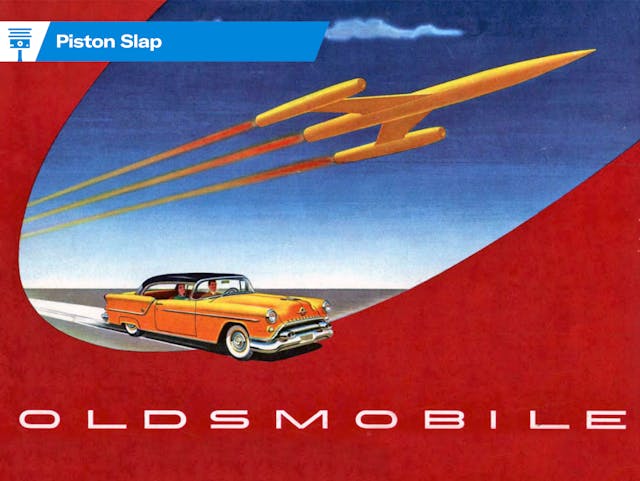Piston Slap: Help for the rough rocket?

Ron writes:
I own a 1954 Olds V8 and want to know how to make it run smoother. You can hear the rods when you first start it, there is a knocking sound. Also the carb hesitates when you come to a stop and then start moving again.
Sajeev asks:
Thank you for your question, Ron! How old is the motor and how many miles does it have? Depending on age and condition, the engine and carb might need to be rebuilt.
Ron answers:
I bought the car in 1983 it had 82,000 it now has 90,000. I don’t know for sure if it was the original miles since it was 29 years old? I am the third owner, and the carb was rebuilt twice in 2019.
Sajeev concludes:
Let’s assume the carb (this one?) was rebuilt correctly. Just ensure the idle is set correctly, it sounds like a little adjustment to the idle bleed screw is all you need. And by “little adjustment” I mean like half a turn with a screwdriver. Or less, much less. Just turn it so the engine speeds up ever so slightly. Then take it for a test drive and see if the hesitation improves.
If not? Rinse and repeat. And if that doesn’t fix the problem, maybe more advanced adjustments (i.e. the idle mixture screws) to the carb are needed.
For the engine noise? Knock upon startup is usually an oil pressure issue. Maybe the oil pump needs a rebuild, but before you tear into the engine, just ensure you’re using the right oil weight. You can run modern diesel engine oil, which has a higher zinc content because your car is pre-1974, which means it doesn’t have a catalytic converter. (Zinc doesn’t play nice with catalytic converters, but you’re in the clear here.) As previously mentioned, diesel-specific oil is readily available online or at local retailers. Try a bottle of oil stabilizer (like Lucas) if the rattle continues after that.
If those fail, consider the aforementioned oil pump rebuild. Or just live with the noise because it’s probably not worth the cost of tearing into the motor. At least not yet. When it comes to engines this old with no repair history, I’d wait for a bigger problem to arise before plunging into a full rebuild. That way you fix everything once, with no superfluous labor costs in the future. Get it done right the first time. But I suspect you don’t need to do that anytime soon. Best of luck!
UPDATE: see the discussion in the comments. If using the right oil doesn’t fix the problem, just rebuild the motor for peace of mind. The less stuff you break internally on a rare engine like this, the better.
Have a question you’d like answered on Piston Slap? Send your queries to pistonslap@hagerty.com, give us as much detail as possible so we can help! Keep in mind this is a weekly column, so if you need an expedited answer, please tell me in your email.
Check out the Hagerty Media homepage so you don’t miss a single story, or better yet, bookmark it.


Sajeev, I wouldn’t wait for a larger problem to arise with a knocking engine. If the problem is a worn rod bearing, there exists the possibility that it could seize on the crankshaft and cause more damage. In my experience with Oldsmobile engines, the main thrust bearing surface seems to get real thin, resulting in a noticeable cold knock. This generally won’t cause a major issue but if the engine is removed and gone through now, there probably won’t be a need to (A) locate another crankshaft, (B) locate another block because a rod went through the existing one, leading to (C,) writing that engine off and sticking an LS in the car. Little problems stay little if they are caught in time.
Hi Anthony, I didn’t consider the possibility of even more serious engine damage happening on a motor that might be hard to source new parts. You are very likely right, and I thank you for sharing your knowledge with everyone!
One thing to try before going the full rebuild route is a in-situ bearing replacement. I do not know that particular car, but I am familiar with the vintage and am willing to bet a dozen donuts that the oil pan can be removed and bearings replaced without removing the engine. Anyone who does (big) truck work is familiar with how to do this, since this is generally how it is done in the semis. Obviously if the first few crank journals show wear (start at the back of the motor), abort and remove engine
Also for the carb issue, look for a vacuum leak, particularly a sneaky one that would not be obvious. Do any vacuum lines go into the cab to run accessories? make sure all of that is sound. It also may be possible that the carburetor is not jetted properly. This will require a true old school hot-rodder and/or carb person to properly diagnose and fix, but something I would look into if that carb has already been gone over multiple times with the same result